Andy Extance looks at the culinary reaction cascade that goes beyond Christmas and Thanksgiving dinner and has worrying links to health
The delicious smell of frying onions pervades the air – but something looks very odd in the pan that Andy Chapman is holding. Chapman, chief scientific officer of Carbometrics, is demonstrating a complex chemical reaction that millions of people perform every day. On one side, off-white crescents of sliced onion are slowly turning golden and brown as usual. But on the other, the onion has melted into a troubling bright yellow mush. Both changes rely on the onion’s natural sugars and proteins, Chapman explains, which heat is helping transform through the Maillard reaction.
French physician and chemist Louis-Camille Maillard originally described how sugars react with amino acids, and the proteins they can link together to make, in 1912.1 He wrote at least eight related papers, with findings including carbon dioxide release as amino acids broke down, and the formation of a brown pigment. Yet Maillard’s work only revealed a soupçon of the reaction’s potential.
We now know that the Maillard reaction is how bread browns to become toast and what helps give roasted coffee its colour and flavour. And at this time of year it provides our festive roasts their golden brown colouration and crispy tastiness. It has also emerged that the reaction is a vastly complex network that shifts in different contexts, as Chapman is highlighting. And, if the joy it brings us through food and drink wasn’t enough, scientists are finding that it’s important in a very different and potentially harmful way.
At first, combining amino acids and sugars was simply called browning, and scientists only started calling it the Maillard reaction around 1947. That’s also about when interest in improving our half-baked understanding heated up, as world war two made mass production of long-lasting and acceptable-tasting food important. In 1953, the US Department of Agriculture’s John Hodge proposed detailed mechanisms, breaking the Maillard reaction into three steps.2
For Chapman, who worked briefly for free in molecular gastronomy pioneer Heston Blumenthal’s three Michelin-starred restaurant The Fat Duck, the very first step is most important. As sliced onions sweat and soften, their cells break down, releasing a complex mixture including sugars and proteins. ‘The reaction really starts between a sugar and a protein, forming a compound called a Schiff base,’ Chapman explains.
But this is harder than it sounds. As Schiff bases, or imines, are the product of a reaction between specific chemical groups, namely amines and carbonyls, not all molecules can take part. Only reducing sugars, like fructose, glucose and lactose, have accessible carbonyl groups. Common table sugar, sucrose, comprises one fructose and one glucose molecule linked together. Sucrose must therefore break apart to react, so Chapman explains that cooking with glucose or fructose makes the Maillard magic happen more quickly.
For starters
Amines likewise face limitations, thanks to classic acid–base interactions. Basic amines can capture protons from acidic sources. Consequently, amine groups in amino acids found in foodstuffs often carry a proton, which they must lose before reacting with sugar aldehydes. Chapman has therefore added an even more basic substance – bicarbonate of soda – to half the onions to raise their pH, and deprotonate the amines. The resulting bright yellow mush is partially due to bicarbonate of soda accelerating the Maillard reaction, he explains.
Once formed, Schiff bases can rearrange to produce molecules such as ketosamines in what Hodge identified as the Maillard reaction’s second stage, actually involving several reactions. Ketosamines can then react in many ways in the third stage, making molecules that can react further in even later stages. Together they produce hundreds of different straight-chain and ring-shaped molecules, with oxygen, nitrogen and sulfur atoms often featuring prominently. However, just a few dozen usual suspects are mainly responsible for food’s aroma and flavour, including furan derivatives like ‘strawberry furanone’. Meanwhile, polymeric melanoidins serve as a pigment, giving cooked food its brown colour.
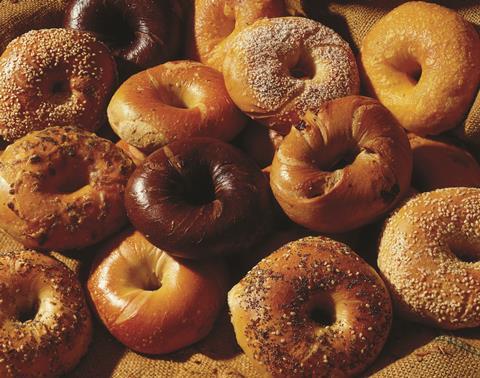
Chefs can hack Maillard flavours by changing cooking conditions. For example, Chapman often melts onions with a pinch of bicarbonate of soda to create a meaty-tasting vegetarian gravy base. And indeed, his yellow onion mush tastes oddly like bacon- or beef-flavoured crisps. Something similar happens in pretzels and bagels. Pretzels arose after someone reputedly accidentally coated bagel dough with lye, containing sodium/potassium hydroxide, rather than egg wash, Chapman says. ‘That raises the pH massively, and it would now go brown very quickly,’ he says, whereas egg washes give a similar but less extreme browning. ‘When we brush the surface of pastry with egg, we’re providing [more] sugar and protein. ’
Although the Maillard reaction can happen at any temperature, it’s typically only noticeable at temperatures above 120°C. That in turn usually requires mostly dry conditions, as water can only get as hot as its boiling point, 100°C. This is one reason that airline food sometimes struggles to live up to its ground-based rivals. The microwaves used to cook the meals do so by heating water molecules in food, therefore facing a 100°C temperature limit. That means food often has to be ‘pre-Maillarded’ before taking to the sky.
Higher temperatures both speed up water evaporation and the Maillard cascade, but beyond 180°C molecules start to decompose and food burns. Chapman therefore recommends pressure cookers, in which temperatures can exceed 120°C. This accelerates the Maillard reaction, enables different reaction cascades and traps volatile flavour and aroma compounds. High pressure also favours reactions whose products occupy less volume, including condensation reactions forming melanoidins, rather than decomposition to small volatile aroma molecules.
These are tools that George Rizzi had to learn to use when he joined Procter and Gamble (P&G) in 1964. He had a PhD in organic chemistry but no prior experience in foods or flavour. ‘I’d never even heard of the Maillard reaction,’ Rizzi says. Yet he quickly learned, using it in his very first project – inventing an artificial chocolate flavour. Rizzi went on to work on well-known US brands like Jif peanut butter and Folgers coffee, as well as Pringles crisps, sold in more than 140 countries. Laws governing standards of food identity limit commercial Maillard-hacking to ingredient selection, and tweaking temperature and pressure, he adds.
The fact that foods contain more than just sugar and protein complicates matters, explains Imre Blank, Nestlé fellow for food chemistry and flavours at the company’s culinary research centre in Singen, Germany. Minerals trigger radical-initiated fat oxidation, and the breakdown intermediates that are formed intervene in the Maillard reaction, he explains. ‘This interplay may be desirable to guide the Maillard reaction cascade; however, it can also lead to phenomena such as off-flavours or limited shelf life,’ Blank says. ‘A careful selection of raw materials combined with the appropriate technology and process parameters allow improved product quality.’
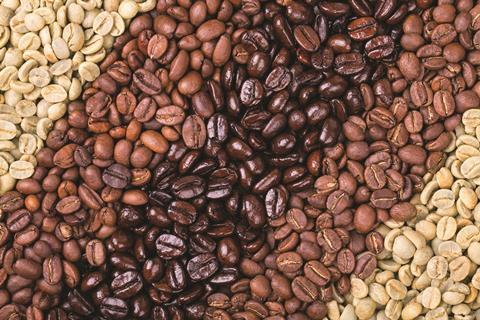
At the International Symposium on the Maillard Reaction in Montreal, Canada, in September 2018, Blank explained how to guide the cascade to favour desirable attributes while limiting negative effects. His strategies include using polyphenols, found in many plant-based foodstuffs, to trap reactive intermediates like radicals and transition metals. Blank also pays careful attention to colour to control coffee or meat roasting. ‘Over-roasted, dark, products tend to be bitter and less nutritious,’ he says.
Yet we can’t necessarily know what changes in conditions will lead to in advance, explains Anja Rahn from the Coffee Excellence Center at the Zürich University of Applied Sciences in Switzerland. ‘The coffee community understands that the Maillard reaction is key to coffee roast chemistry and there are excellent Maillard reaction scientists out there,’ she says. ‘Nevertheless, it is bridging the gap between understanding the theoretical side of the Maillard reaction and applying this understanding in a predictive fashion to coffee and the roast process that requires further development. Our inability to predict the Maillard reaction in food systems suggests that there is still value to be gained through Maillard reaction research. Knowledge-based food formulation should be the goal.’
The darker side of browning
Roughly 20 years ago, such maturing knowledge identified one Maillard product that was especially unappetising: acrylamide, whose potential cancer risk the World Health Organisation considers a ‘major concern’. Rizzi started to explore the problem with his colleagues just before he retired in 1999 – since when P&G has sold all of its food businesses. After a series of papers from different groups flagging the danger in 2002,3–5 P&G published its research in 2003.6

‘I was part of a team organised to identify the mechanism of acrylamide formation during potato frying,’ Rizzi explains. ‘Our experiments confirmed that the natural potato amino acid asparagine was a key source of thermally generated acrylamide. Subsequent effort was devoted to reduce or eliminate asparagine in Pringles’ raw materials.’
EU rules on acrylamide came into force in April 2018. Its benchmark acrylamine levels range from 40µg per kilogram for cereal-based baby food, to 750µg per kilogram for crisps and 850µg per kilogram for coffee. Potato products account for 67.1% of adult acrylamide consumption in the UK, 60–80% of which is from French fries, with crisps and oven-cooked potatoes contributing the remainder.
The UK’s Food Standards Agency tracks levels of both acrylamide and some furans – also possible carcinogens, and therefore monitored but not restricted. In its latest results, for the period to November 2017, acrylamide levels were lower than the benchmarks on average, but with several companies exceeding them. Pringles, perhaps unsurprisingly given P&G’s work on acrylamide, were the crisps with the lowest acrylamide content, at just 25µg per kilogram.
For those that exceed the benchmark, many studies have now shown how to successfully avoid acrylamide while maintaining aroma, taste and colour. Often that involves using asparaginase enzymes to break down asparagine in ingredients before cooking. But Stephen Elmore from the University of Reading in the UK and his colleagues have been exploring potato variety choice.7 ‘Acrylamide formation correlates quite well with brown colour, and is inversely proportional to starch content and crispness,’ he says. ‘Therefore, crisps made from potato varieties suitable for crisp making are generally low in acrylamide, relative to crisps that are made from potatoes that you might use for mash, like Desiree, Harmony and Maris Piper.’
Elmore and colleagues have also found that in some potato varieties, starch breaks down into simple sugars that can take part in the Maillard reaction more than in other varieties. ‘My work showed that Hermes, a formerly popular crisping variety, performs badly in storage, while Fontane and Markies were varieties not previously used for crisps, which may have potential,’ he says. However, even they would struggle to meet the 750µg/kg limit, Elmore adds. It may be possible to explore other new potato varieties, but very high starch levels that translate to very low acrylamide levels, ‘may give crisps that are too crisp’.
People concerned about acrylamide should therefore keep potatoes out of the fridge, Elmore advises. That’s because chilled storage increases levels of reducing sugars, and therefore more acrylamide when cooked. But he also makes a few points that may ease people’s minds. Firstly, acrylamide carcinogenicity has still not been proven in humans. Secondly, the brown melanoidin polymers produced by the Maillard reaction are antioxidants that might counteract toxicity from compounds produced in the same process. And thirdly, the Maillard reaction naturally occurs in our bodies at a very slow rate.
New takes on classic ideas
These natural Maillard reactions are increasingly interesting to many scientists considering their health implications, including Chapman’s company, Carbometrics, based at Bristol incubator Unit DX. ‘This is where it all started for Louis Maillard, looking in physiological systems,’ he observes. ‘We have sugar circulating around in our blood, and we’re covered in amines from all our proteins.’ The process happens slowly, but our relatively high concentrations of blood glucose help. That’s especially significant for diabetics, whose problems regulating blood glucose mean that concentrations can stay higher for longer. ‘The pathology of the disease is very strongly linked to the change in function of proteins that is a result of glucose reacting with those proteins,’ Chapman adds.
Chapman and his colleagues are therefore working on a glucose-binding molecule platform, originally spun out of the University of Bristol, UK, as a startup called Ziylo. Danish pharmaceutical company Novo Nordisk bought full rights to the platform in a deal worth up to $800 million (£610 million) in August 2018. Their hope is that these glucose-binding molecules can enable insulin-like substances that can detect high blood glucose and trigger biological processes to reduce them. Following the acquisition, some research activities were spun out of Ziylo to form Carbometrics, which now wants ‘to create the next generation of glucose sensors’, Chapman says.
But when it comes to the Maillard reaction in food, while Chapman accepts the regulations, he personally worries little about acrylamide in his home cooking. ‘If you look up all the compounds that are made in the Maillard reaction, I think many could be considered toxic,’ he says. ‘They’re in there in a very small quantity and we’ve been eating them for many years.’
That wide array of substances reflects that, even after more than a century, in many ways we’ve barely had a taste of what Maillard reaction complexity has to offer. We are, however, better placed than ever to harness it in a tasty Christmas or Thanksgiving meal.
Chapman says he would separate a turkey into joints, cook the breasts at around 60˚C ‘sous vide’ (under vacuum in a water bath) to keep them moist, while slowly oven-roasting the legs. He’d then bring in the Maillard reaction at the last minute, pan-frying the meat to brown it. Modern chefs often do this when cooking meat, Chapman adds, to get the most tender, tasty outcome. ‘My top tip would be: don’t cook the turkey for five hours in an oven to try to get it brown. And of course I’d do my gravy in a pressure cooker.’
Andy Extance is a science writer based in Exeter, UK.
References
1 L C Maillard, Compt. Rend., 1912, 154, 66
2 J E Hodge, J. Agric. Food Chem., 1953, 1, 928 (DOI: 10.1021/jf60015a004)
3 E Tareke et al, J. Agric. Food Chem., 2002, 50, 4998 (DOI: 10.1021/jf020302f)
4 R H Stadler et al, Nature, 2002, 419, 449 (DOI: 10.1038/419449a)
5 D S Mottram et al, Nature, 2002, 419, 448 (DOI: 10.1038/419448a)
6 D V Zyzak et al, J. Agric. Food Chem., 2003, 51, 4782 (DOI: 10.1021/jf034180i)
7 J S Elmore et al, Food Chem., 2015, 182, 1 (DOI: 10.1016/j.foodchem.2015.02.103)
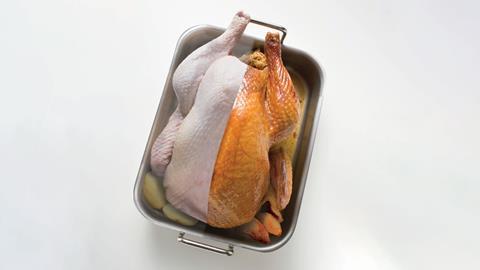



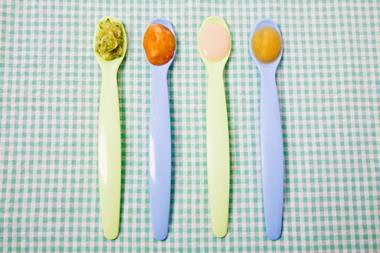

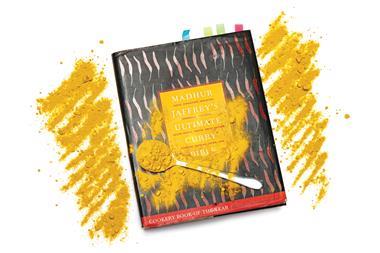






No comments yet